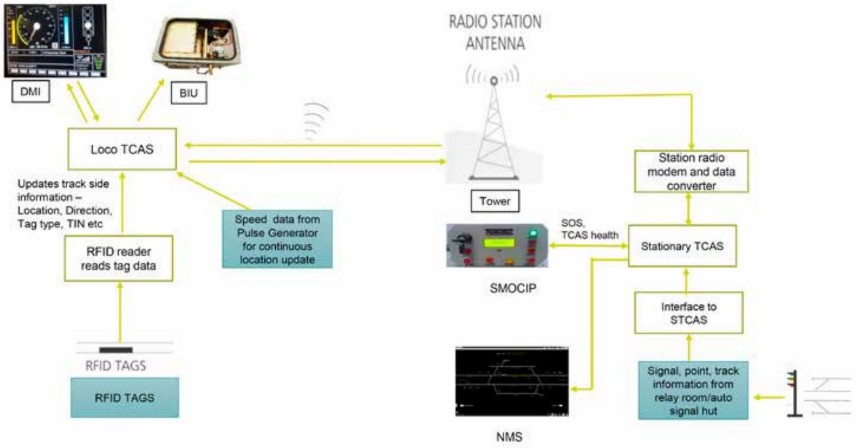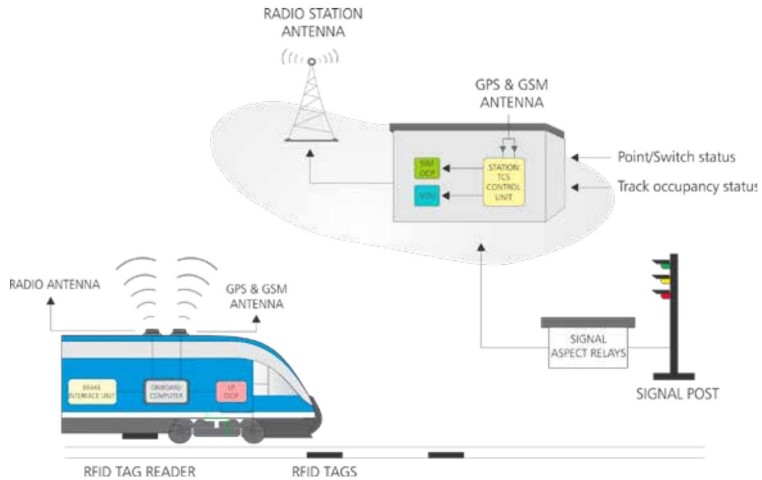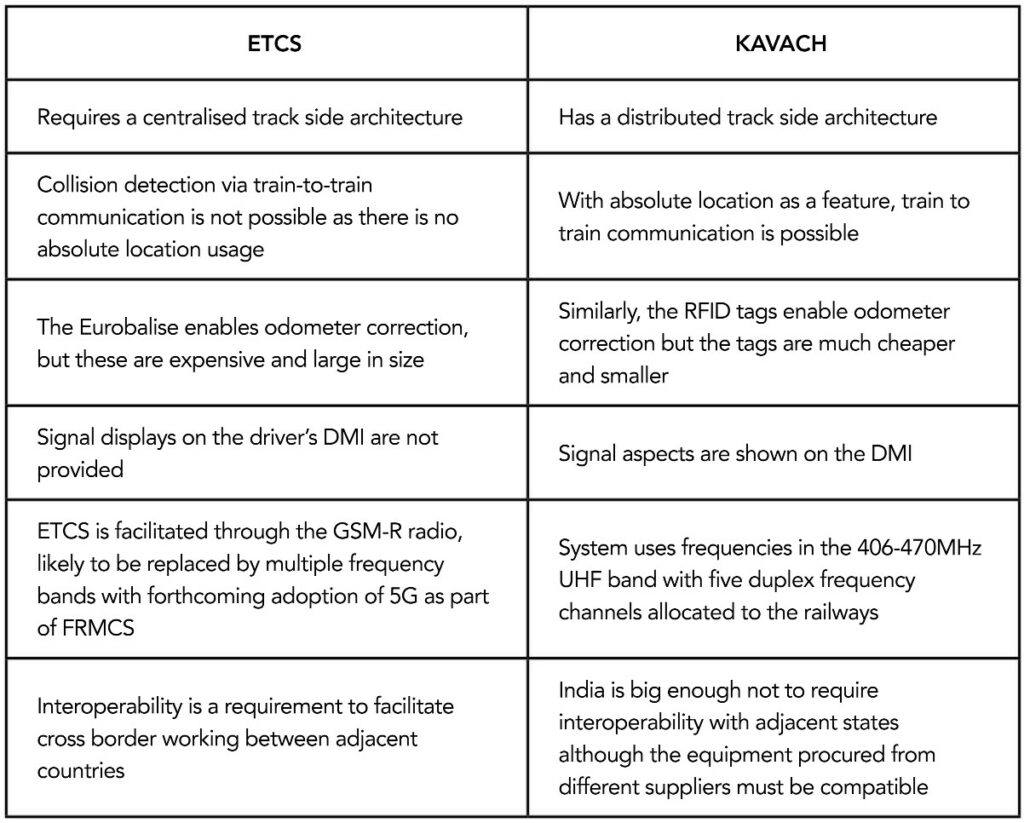Automatic Train Protection (ATP) is always a hot topic. Railways across the world are forever grappling with the need to provide train drivers with additional facilities that enhance the safety of operation, and prevent human errors such as passing signals at red. Very often, ATP systems are linked with technology that can improve capacity, the ‘holy grail’ being the introduction of ERTMS and ETCS which achieve all these objectives and eliminate much of the lineside equipment if implemented in full. However, as was remarked in the recent review of the Digital Railway (Issue 200 Jan/Feb), ETCS, whilst relatively easy on new high-speed lines with captive rolling stock, is proving much harder to apply on to existing mixed traffic railways than originally thought. Not only is it expensive to provide, but the return on investment might take decades to achieve.
Indian Railways, which has a vast network, is anxious to provide an ATP system and scoured the market to see what could be obtained from the various signalling suppliers from around the world. None of the systems on offer fulfilled its requirements and expectations, so it seized the initiative and decided to develop its own system. This has resulted in KAVACH, a system built upon standardised piece parts put together in a manner that results in a cost-effective ATP product. A recent talk given to the IRSE London & SE section by Priya Agrawal, deputy chief S&T engineer on Indian Railways, gave her the opportunity to showcase the system beyond the country’s borders.
Requirements
- The need to define what the ATP system should achieve is an important first step. In basic terms, the Indian National Rail Plan requirements by 2030 are to:
- Improve operational capacity;
- Increase freight speeds to 50km/h;
- Grow rail freight by 45%;
- Increase speed on Delhi Howrah (Kolkata) and Delhi Mumbai routes to 160km/h;
- Increase speeds on other main routes to 130km/h.
To facilitate this, the ATP system has been developed to achieve:
- Prevention of SPADs;
- Roll back and collision prevention;
- Display of signals into driver’s cabs;
- Automatic whistling at level crossing gates;
- Intelligent real time health monitoring.
The Indian ATP system design comprises three basic elements:
- Trackside – Station Intelligence and data gathering unit, RFID (Radio Frequency Identifiers) positioned between the running rails;
- On Board – RFID readers, Brake interface equipment, UHF, GPS and GSM aerials and associated transceivers, on board vital computer;
- Radio Communications – Towers and antennae, radio modems, UHF radio system for transmission and receiving of information.
There is no intention to remove lineside signals at the present time, thus easing the requirement for locomotive fitments and captive fleets. The foreseen data flow is via the radio network which will provide all messaging between trains and the trackside.

Developing the system
The Indian ATP has been in development since 2011. By 2012, a proof of concept had been achieved followed in 2013 by the granting of a development order for design and manufacture by contract. The system had to have multi-vendor interoperability. In 2014, a trial system was deployed on a 265km section of line followed by field trials over the period 2015 to 2017, with final approval being given in 2018/2019. Training the IR staff to take on maintenance proceeded in 2020/2021, whence roll out is ongoing. Ongoing work includes addition of new features and system refinements.
The system in operation
The situational awareness relies on a continual data flow between trains and the trackside. The train-borne equipment continually sends data messages to the trackside stations which give train identity, speed, direction, the track upon which the train is travelling, and location. This information is achieved by an onboard vital computer module that connects to: i) an onboard odometer to measure position and distance travelled which is periodically reset as the train passes over the RFID tags; ii) an electronic input from the speedometer; iii) the time data derived from the GPS satellite information that also acts as a time synchroniser; iv) an interface to the train braking system; v) a driver’s screen interface; vi) a power supply unit; and vii) an event recorder.
All of this is consolidated and sent to the control stations over a UHF radio system. In addition, the data is transmitted via the GSM radio to a Network Management System that logs all messages including all input functions, train movements, any incidents of forced braking, and every fault message. From these logs, SMS messages are sent to fault teams.
At the signalling control stations, the KAVACH vital computer equipment processes the input data and interfaces this to the interlocking to produce information on signal aspects, permitted speeds, any speed restrictions from which a movement authority is sent to the train. The driver is expected to obey the information given. With the continual interchange of data, including speed and position information, should the train not comply with the information displayed then automatic alerts and braking will take place until the train progression is commensurate with the instructions generated. It must be remembered that the instructions are there to complement the lineside signals, which the driver should be obeying as if the KAVACH system was not installed. It is not the intention at this stage for signals to be removed.

Equipment, safety and reliability
Indian Railways are keen to stress that the KAVACH system conforms to CENELEC standards. These are EN 50126:1999, covering specification and demonstration of RAMS; EN 50128:2011, relating to software for railway control and protection systems; EN 50129:2003, concerning safety related electronic systems for signalling; and EN 50159:2010, covering safety related communication in transmission systems.
In addition, the KAVACH system complies with the SIL 4 standards normally associated with the EU.
The track mounted RFID tags can be used for additional purposes in addition to distance travelled and include a signal approach tag, level crossing approach, and KAVACH exit tag. Different tags are used on adjacent lines to avoid cross reading.
Retrofitting the traction units with KAVACH equipment is a challenge as it is on many other railways. Finding sufficient space and making the locomotives available for the work to be carried out, especially as many different types exist, requires the co-operation of all operating and engineering departments.
Remote interface units are positioned at level crossings, intermediate block locations, and automatic signals which are connected via a ring based transmission link back to the relevant KAVACH station units.
The UHF radio network is designed using different time slots within five nationwide channels which are allocated dynamically at the station equipment. The trains will only respond to their assigned time slots which are synchronised by the GPS time reference signal. In an emergency, the time slot can be overridden if an urgent message is required to be sent. Changeover between channels is achieved automatically at a defined location between the controlling stations.
Reliability numbers are impressive: The station equipment achieves 60,000 hours between failures, and the train equipment is slightly less at 40,000 hours. An overall availability of 99.9% is achieved. The vital computer equipment, the fixed and remote interface units, the power supply units, and the communication modules are all duplicated.
An interesting facility which adds to the ATP system is the automatic calculation of train length. This is achieved by having time stamps for the pick and drop of track circuits, which, together with train speed, enables the calculation to be made. It is accurate enough for ATP but would need some refinement if ever used for ATO.
Comparisons
On reading all of this it would be easy to ask why, if the Indian system performs similarly to ETCS, Indian Railways did not use this? It is a fair question but there are logical answers. The first and most fundamental response is that KAVACH is intended as an overlay to the existing signalling regardless of the type of signalling installed. Train operation will continue whether or not the ATP system is there to support it. As indicated earlier, KAVACH is much cheaper, thus improving the business case for investment. Being piecemeal, it is also much easier to install and commission since it can be introduced on sections of line that are being upgraded without the whole route having to be commissioned.
There are also technical differences:

Deployment and the future
To date, KAVACH has been installed on 1,365km of route and 131 traction units have been equipped. Contracts are let for a further 2200 route kilometres and the equipping of 580 locomotives.
Development is underway to interface KAVACH with electronic interlockings, to integrate the system into traffic management systems, and to consider how the system will work with a new railway radio network that will utilise LTE standards.
The Indian Railway’s engineers are to be congratulated on producing a pragmatic and cost effective technology that will be part of the plans for greater capacity and enhanced speeds on its rail network. The old adage ‘where there is a will there is a way’ must truly apply to this project.

